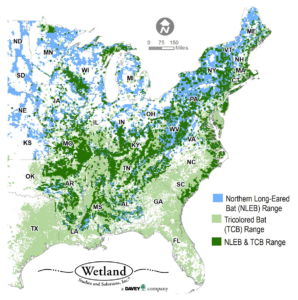On October 23, 2024, the U.S. Fish and Wildlife Service (USFWS) released final tools and guidance documents relating to the federally endangered northern long-eared bat (NLEB) and the proposed federally endangered tricolored bat (TCB). Draft versions of the tools were previously released on April 1, 2024, with a 30-day public comment period for input by stakeholders (see our April 17 Field Notes article for more information). The final tools and guidance documents replace the interim draft guidance and will be applicable to TCB if it is listed as endangered under the Endangered Species Act (ESA). At this point, the date at which TCB may be listed is unknown. Wetland Studies and Solutions, Inc. (WSSI) has been monitoring the bat protection changes and will update in future Field Notes with any news on listings and regulatory processes.
New NLEB & TCB Determination Key
The new Rangewide Northern Long-eared Bat (NLEB) and Tricolored Bat (TCB) Determination Key (DKey) has replaced the now familiar Northern Long-Eared Range-wide Determination Key within the USFWS Information for Planning and Consultation (IPaC) system. This DKey should be used for current and new projects starting immediately. USFWS recommends that project proponents re-run projects in IPaC to obtain a new Official Species List (OSL) as species range mapping was updated with the release of the new DKey. If the NLEB or TCB comes up on projects OSL, project proponents should utilize the new DKey to reach an effect determination.
The DKey includes questions about specific project activities and asks if tree clearing will occur during the summer occupancy season for the NLEB, the pup season for the TCB, and the winter torpor season in areas where the bats are active year-round. If project activities include impacts to suitable bridge/culvert habitat, then assessments may be required before a determination can be provided through the DKey.
How Does This Affect My Projects? (Consultation Guidance)
 The USFWS released the Final Consultation Guidance for Development Projects as a tool for the NLEB and TCB, and it will apply to the TCB if it is listed. This guidance is applicable to a wide variety of projects and offers conservation measures that can be utilized to minimize adverse impacts to these bat species. Notably, these measures include a time of year restriction (TOYR) on tree clearing during the pup season for both bat species. Potentially applicable TOYR periods, such as the winter torpor, summer occupancy, and/or pup season, are based on the bat activity seasons which are outlined in Appendix 2 of the Guidance.
The USFWS released the Final Consultation Guidance for Development Projects as a tool for the NLEB and TCB, and it will apply to the TCB if it is listed. This guidance is applicable to a wide variety of projects and offers conservation measures that can be utilized to minimize adverse impacts to these bat species. Notably, these measures include a time of year restriction (TOYR) on tree clearing during the pup season for both bat species. Potentially applicable TOYR periods, such as the winter torpor, summer occupancy, and/or pup season, are based on the bat activity seasons which are outlined in Appendix 2 of the Guidance.
Projects that include wind turbine operation or sustainable forestry have their own standalone guidance documents.
What Hasn’t Changed?
The Interim Consultation Framework (ICF) for the NLEB published on March 31, 2023 (latest version dated April 8, 2024) remained in effect for use until November 30, 2024. This framework does not apply to the TCB.
WSSI Can Help!
WSSI staff are here to support your projects with any bat-related concerns. Please contact your WSSI project manager or the staff listed below to discuss how the changing bat regulations may impact your projects.
[i] USFWS considers all bridges and culverts longer than 23 feet in length and wider than 3 feet in diameter for TCB or wider than 4.5 feet in diameter for NLEB as potentially suitable habitat.
